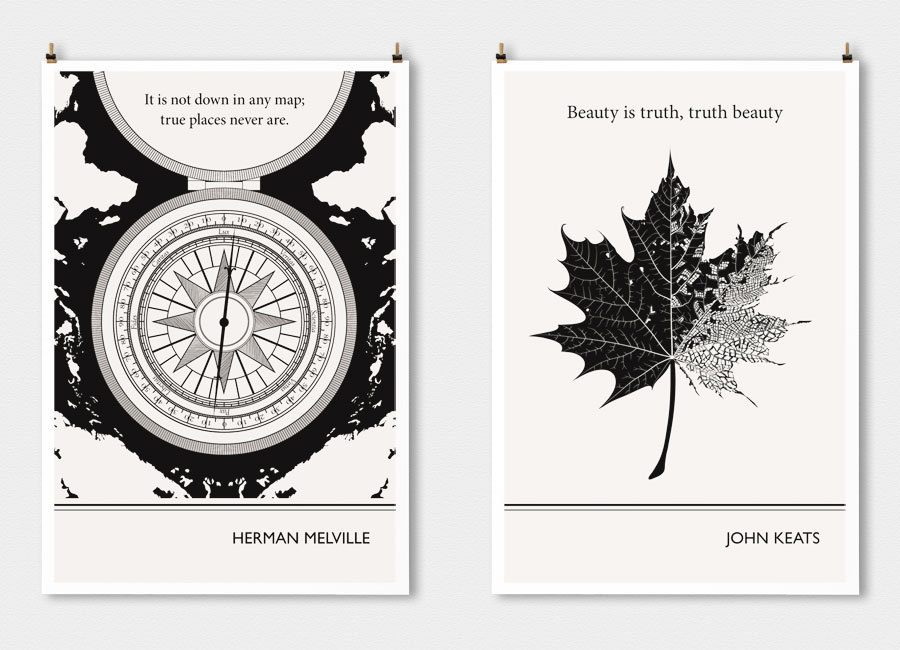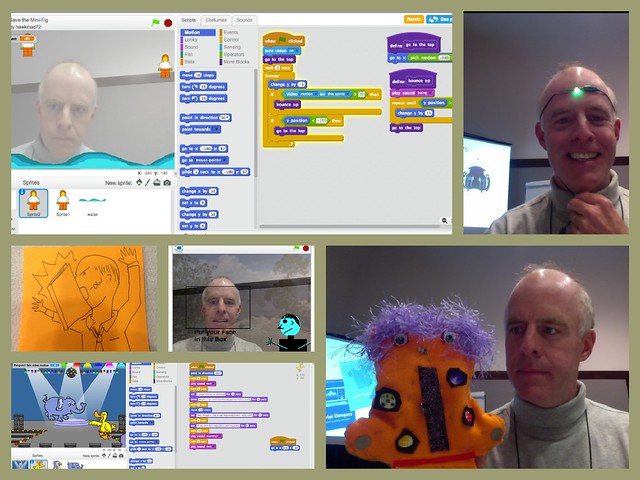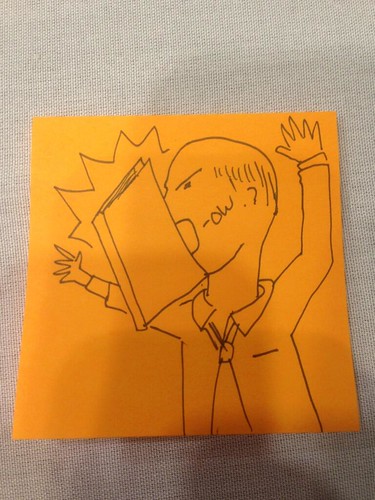
I love this project that merges literary with design. Read more about the work of Evan Robertson over at Huffington Post. There’s even an old interview with the artist that is worth checking out.
Peace (in lit),
Kevin

I love this project that merges literary with design. Read more about the work of Evan Robertson over at Huffington Post. There’s even an old interview with the artist that is worth checking out.
Peace (in lit),
Kevin

I just completed the last phase of the Make/Hack/Play mini-course facilitated by Karen Fasimpauer, and earned this nifty badge/certificate. The course had a few activities around making and remixing and reflecting, and I liked that the scale was small and doable. And fun. Karen will be running the course again in January, I believe. If you are curious about making and tinkering and remixing, this free mini-course is a great way to dip your toes into the water.
Peace (in the sharing),
Kevin
The Daily Create for DS106 was to create a video promo for DS106 Radio. I am still getting used to the updated iMovie, which comes with expanded “movie trailer” options. Here, I took clips from the radio-infused Air Heads and popped it into a trailer template, and created this bit of video anarchy:
Peace (in the radio waves),
Kevin

There are many things to like about an educational conference like NCTE. Sure, the collaboration and sense of community, and shared knowledge and expertise is all wonderful. But there is also … the free books that publishers hand out in the Exhibition Hall, and this year, my wife and I took home many, many bags of free books (we drove this year so we just kept dragging bags to the car). Plus, we got a few bookmark packs, tattoes, and even a “graphic story” builder pack.
My students will love perusing the pile.
Peace (on the pages),
Kevin

I had the great honor and pleasure to take part in a fast-paced Ignite Session at NCTE in Boston. Ignites are quick presentations, where the 20 slides move on a synced delay and you need be concise and in focus. Five minutes and you are done. My own Ignite presentation was about using video game design in the writing classroom. But to share the stage with Penny Kittle, Sara Kajder, Donalyn Miller, David Finkle, Sandy Hayes and others was a blast.
Here are a few notes that I scratched out on paper as I listened to the others on the stage (videos will be forthcoming from NCTE in the near future):
Sandy Hayes (who facilitated the Ignite session with the theme of Core Standards: Minding the Gaps)
David Finkle (Igniting Insight and Interest)
Penny Kittle (Book Love: Building Reading Lives that Last)
Kevin Hodgson (that’s me!) — (More Than a Game)
Troy Hicks (To Produce and To Publish Writing: Infusing Digital Writing through the Common Core)
Andrea Finkle (It Could Be Verse: The Lack of Poetry in the CCSS)
Scott Filkins (Performance Assessment: Making the Reading Process Visible)
Zenatta Robinson (Make it Pop!)
Sara Kjader (Pedagogies of the Possible)
Sarah Brown Wessling (Reading in Liminal Spaces)
Donalyn Miller (Dead Presidents and Whales: Engaging Students with Nonfiction Texts)
I’ve linked as many Twitter accounts as I could find to presenters, and suggest you might want to follow them.
Peace (in the ignition),
Kevin

My wife came home from a Librarian’s Convention with the observation that publishers have now gone completely overboard on non-fiction books. I suppose that is the case (thanks, Common Core!). It’s not a bad thing to have some solid non-fiction but her impression is that good fiction titles have suffered as a result.
I Am George Lucas is part of that growing non-fiction trend aimed at elementary students. Particularly, boys. The biography (not autobiography, oddly enough, given the title, which is misleading. While Lucas provides a quick opening introduction, the rest of this short book is a standard biographical account of Lucas) is a quick read, aimed at third and fourth graders. There’s not a lot of meat in these bones, so to speak.
But for those interested in the life of the man who envisioned Star Wars and Indiana Jones and a few other classic movies (I’m not sure American Graffiti will ring in the heads of young readers), this book does the trick of hitting the key moments of Lucas’ life, growing up with no real focus until college, when he realized that he wanted to make movies. We see his partnerships with Francis Ford Coppola and Steven Spielberg, and others, that opened doors for Lucas that would otherwise have been shut.
You come away from the book with a sense of not only the vision of Lucas but also the drive and courage to stand up to Hollywood at times (he could have used some more outside voices for editing the most recent batch of Star Wars movies, in my mind, but critical views of his movies are almost nonexistent here). I like that they show how Lucas is using his wealth to push filmmaking forward and his work around philanthropic issues, such as education.
I am George Lucas is not a classic, but it is readable and informative.
Peace (in space),
Kevin
At NCTE, I gave two talks with a theme of Video Game Design (and just so you know, I don’t spent the year with video games although you might get that impression if you were in both sessions.) I use Scoop.it as a way to curate interesting resources and ideas around video game design for the classroom. This is my Video Game Design Scoop. Feel free to follow and borrow.
Peace (in the sharing),
Kevin
If you missed the NCTE Hackjam, you missed out on some great fun, and some great conversations among teachers (armed with tiny scissors and glue sticks and comics) about how to critically use media for analysis and meaning. It began with some stealthy signs and stealthy tweets, and Hackjam instigator Chad encouraging anyone walking by to take on a secret mission. Our mission was to grab some swag from NCTE vendors and use the materials to create new media. All of this as we huddled on the floor of the hallway off NCTE central.
In a nod to my friend, Anna, who created an Animoto while the HackJam was in progress, here is my own Animoto of the event, with a focus on the collage comic that I created to poke fun at a publishing company.
Chad then showed folks how to use some of the Mozilla Webmaker tools to create online hackjams, including a new Thinmble function for collaborating on a webpage project.
Peace (in the hack),
Kevin
PS — Thanks so much to Andrea Zellner and Chad Sansing for bringing HackJam to NCTE again.
I led a roundtable discussion yesterday at NCTE around nurturing teacher voices, and my roundtable topic was about how to encourage teachers to use their local newspapers as a platform for writing and publishing, and changing the dialogue around education. The work is informed by a strong partnership that our Western Massachusetts Writing Project has with a regional newspaper to feature teacher-writers once a month. I used this handout as a way to encourage individual teachers but also groups of teachers to consider the local newspaper as a conduit for positive news.
NCTE Session Getting It in the Paper by KevinHodgson
Peace (in the news),
Kevin
While at the second day of the National Writing Project meeting, I spent the morning in a session around Scratch and coding for storytelling, and then the afternoon in a session around e-textiles and puppetry, and how to use circuits for storytelling. This collage shows a few photos from the day:

There was a definite Makers Ethos to the NWP sessions this year, beginning with a plenary talk about the value of remixing Moby Dick and other works of literature. And speaking of remixing Moby Dick, a cool thread of iteration happened over the course of the day, as my friends Chad and Andrea launched a Twitter activity called #Twitcatastrophe, in which folks made suggestions for strange things happening and Chad and/or Andrea would illustrate it and tweet it out.
I suggested a literal close reading in which the book snaps shut on the reader’s nose.
First, Chad drew this:

Then, in our Scratch session, Andrea created this:
I went in and remixed her project, adding the element of the reader itself:
And Christina came over and shot a Vine of Andrea and the game:
It was a blast, and reminded all of us how iteration and inspiration and creativity are at the heart of the remix culture. Each step — from creating the twitter game to the reader/artist response to the gameplay and remixing of the game — are different points on the compositional spectrum that we need to nurture and value.
Peace (in the make),
Kevin